I sing (tenor) with the Orpheus Choir of Toronto. When you sing with a community choir, one of the expectations is that if you have gifts (quite apart from your voice) you will place them at the choir’s disposal to contribute to its success as an organization. And so I am called upon, now and again, to show up with my camera. It’s given me occasion to think about the mechanics of shooting both choral groups and individual choristers. However, I haven’t been able to put my thoughts into practice, at least not in a concert setting with Orpheus, because it’s hard to sing and shoot at the same time. Fortunately, in the last few years, there has been an explosion of high quality choral groups in the Toronto area. With that has come a corresponding explosion in demand for choral photography.
I’ve recently had the pleasure of working with the Canadian Men’s Chorus as they update their promotional material. The CMC is in its sixth season, with Greg Rainville as artistic director and Arlene Jillard as manager.
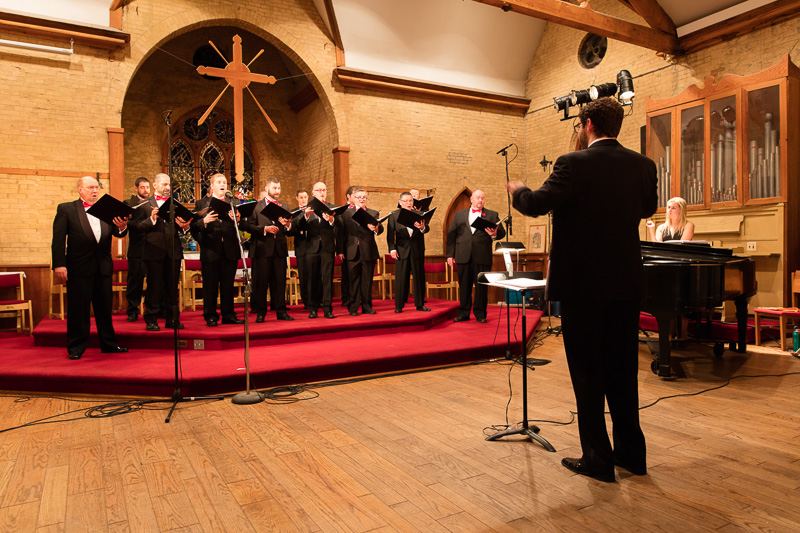
Here are some thoughts about shooting choirs, by no means exhaustive:
This is NOT wedding photography.
If you expect to shoot a group of people standing static on risers and smiling for your camera, you’ll be shooting something that looks like a choir, but it won’t be a choir. Choirs are anything but static. Sometimes, I think choirs are dance ensembles that happen to sing. Choral music engages the whole body.* There are the obvious things: the lungs, the tongue, the palate, the lips, the face. But the feeling radiates out from there. The body sways with the rhythm. Feet tap to the beat. The whole spirit vibrates and, if it’s a good choir, those vibrations start to move the audience too.
Sometimes, body movement is deliberate, as illustrated by the shot below where the CMC sings the world premiere of “Boots (Infantry Columns)”, Don MacDonald’s TTBB setting of a Rudyard Kipling poem about infantrymen on the march. Footsteps (and snare drum) supplement the work’s martial character.
Think of shooting choirs as more like street photography than wedding photography. You’re looking for that decisive moment—a facial expression, a meeting of eyes, a sway in the body as the music transports the singer.
(In fairness, good wedding photography is not wedding photography either.)
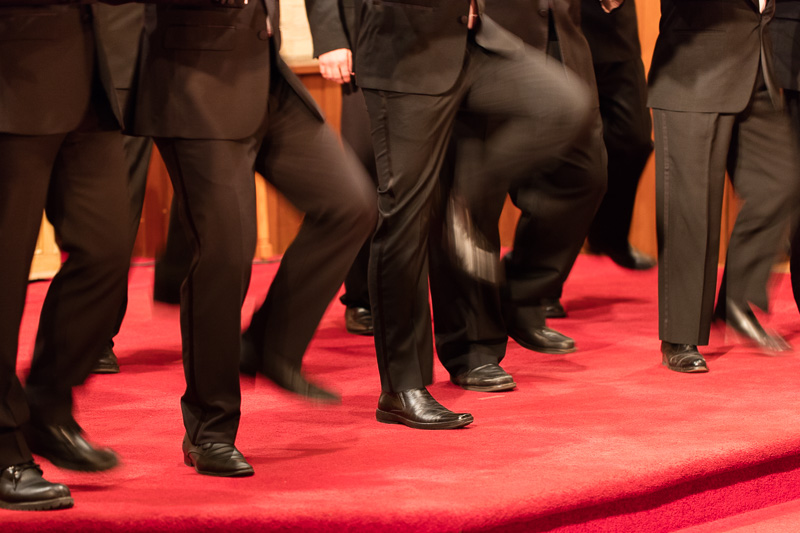
Respect the performer’s dignity.
My second observation flows naturally from the first. Shooting choristers as they sing can be a lot like shooting people as they chew on their food. When singers work to give their words clarity, they contort their faces. Captured as stills, the resulting expressions can be unflattering, or even frightening. Shoot continuously through a range of motions, keep whatever works, discard the rest. Better yet, wait for held notes when the face isn’t doing a lot of weird things.
Related to that is eye contact. In a perfect world, all choristers watch the conductor all the time. When still photos catch a chorister with their nose buried in the score, it’s incriminating evidence. A flattering photo is one that captures the chorister staring attentively at the conductor with smiling eyes. Yes, smiling eyes. As I am learning from my own choral experience, eyes that smile help to produce a brighter sound.
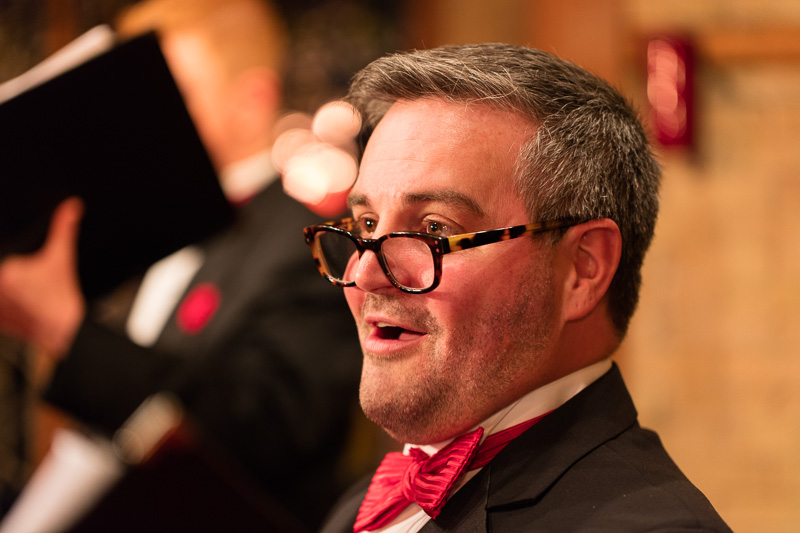
Community choirs aren’t church choirs.
I can’t speak for Europe, but in North America, community choirs have a branding challenge. They are secular organizations heavily reliant on funding from secular sources (government & charitable foundations), and many (including both Orpheus and the CMC) are committed to commissioning new works that reflect the huge cultural shift from sacred to secular that engulfs us all. At the same time, unless a choir can pack a large concert hall, the best venues are churches. Acoustically, most churches are designed to amplify the sonorities of a choir. They also serve well as mid-sized concert venues. The problem is: they’re full of religious paraphernalia.
The challenge for the photographer is: you’ve been asked to photograph a secular organization, but all your images end up with religious symbols and churchy-looking architecture in the background. There are workarounds but no perfect solutions. One technique is to use a shallow depth of field to make the background blurry. This is fine for blurring out small crosses and whatnot, but never really eliminates obvious architectural features like gothic arches. A second technique is to fill the frame with individual choristers, which is fine but never answers the challenge of shooting the entire ensemble. A third technique is to clone out sacred details in your favourite image editing software. Effective, but labour intensive.
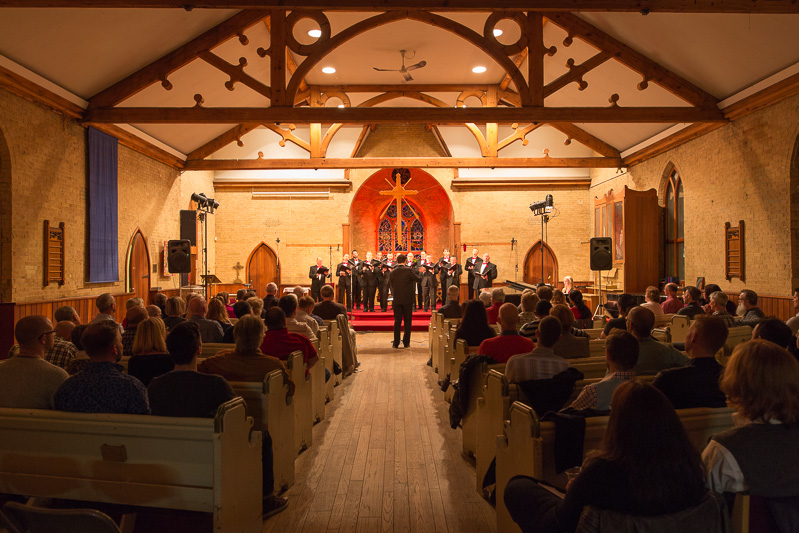
Choristers in community choirs are like superheroes.
During the day, they go about their ordinary lives. Working. Going to school. Making meals. Caring for children. Picking up poop after their dogs. But when the sun goes down, they assume a new identity. They put on gowns and bow ties. Or if they’re off to rehearsal, they fill their water bottles and sharpen their pencils. Like superheroes, their involvement in community choirs is voluntary. That means their time is limited. It’s difficult to gather them all for a dedicated photoshoot. Instead, you most likely have to shoot at times when the choir is already gathered. Rehearsals and concerts. The problem with shooting during rehearsals and concerts is that choirs already have something to do: rehearse and perform. Artistic directors have things they want to accomplish during rehearsals. Those things are musical, not photographic. It’s important for the photographer not to interfere with those aims.
Yes, get your shot, but be unobtrusive. Don’t get in the way of sight lines. Turn the camera to silent mode so it doesn’t make beeps when you release the shutter. In performance, time the shutter release to moments when the choir is singing forte so your clicks don’t disturb the audience. Wear quiet shoes and dark clothes. Show up early for the performance so you can catch the choir warming up. That way, you can get “performance” shots (i.e. the choir singing in concert dress) from positions you wouldn’t be able to occupy during the actual performance.
Catch the next concert of the Canadian Men’s Chorus on May 7th 2016: On Growing Up.
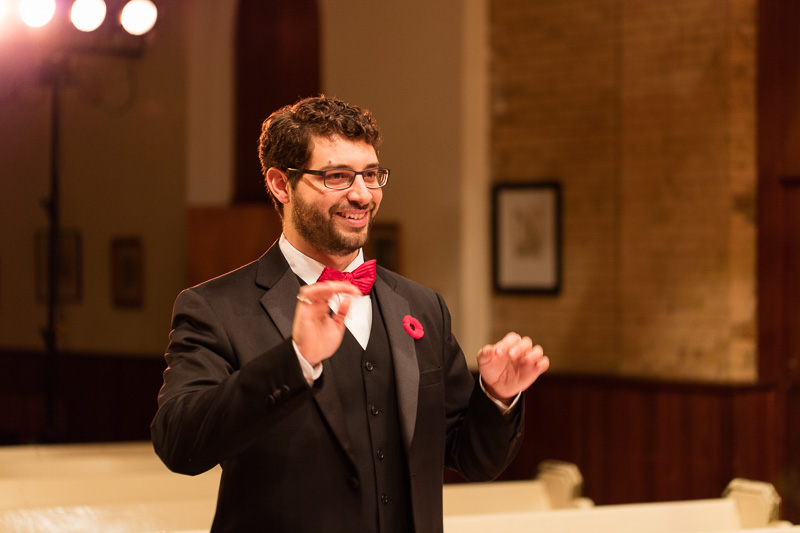
* People who know me and how stiff I can be may find this amusing. Treat my writing as aspirational. It reflects an ideal, not something I actually accomplish.